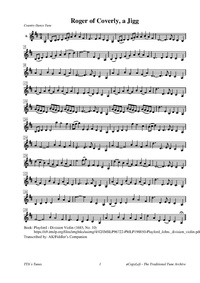Template:Pagina principale/Vetrina: Difference between revisions
No edit summary |
No edit summary |
||
| Line 1: | Line 1: | ||
{{SheetMusic | {{SheetMusic | ||
|f_track= | |f_track=Sir Roger De Coverley.mp3 | ||
|f_pdf= | |f_pdf=Roger of Coverly.pdf | ||
|f_artwork= | |f_artwork=Sir Roger De Coverley.png | ||
|f_tune_name= | |f_tune_name=Sir Roger de Coverley | ||
|f_track_title= | |f_track_title=Sir Roger de Coverley | ||
|f_section=abc | |f_section=abc | ||
|f_played_by=[https://soundcloud.com/ | |f_played_by=[https://soundcloud.com/p-a-barn-dance Pump Action Band] | ||
|f_notes= | |f_notes=Sir Roger de Coverley and gypsies, 1840 engraving. | ||
|f_caption= | |f_caption=Roger, so named from the Archbishop of York, was a person of renowned hospitality, since, at this day since, at this day, the obsolete known tune of 'Roger a Calverley' is referred to him, who, according to the custom of those times, kept his Minstrels, from that, their office, named Harpers, which became a family, and possessed lands till late years in and about Calverley called to this day Harpersroids and Harper's Spring. | ||
|f_source=[https://soundcloud.com/ | |f_source=[https://soundcloud.com/p-a-barn-dance/sir-roger-de-coverley Soundcloud] | ||
|f_pix=420 | |f_pix=420 | ||
|f_picpix=200 | |f_picpix=200 | ||
|f_article=[[ | |f_article=[[Sir Roger de Coverley | '''Sir Roger de Coverley''']] | ||
The tune has had a long history in English country dance, retaining its popularity almost until the present-day. One source gives that the air is printed in Playford's '''Dancing Master''', 1650, p. 167 (though other sources say it did not appear until later editions of the '''Dancing Master''' starting in 1669). | |||
Dr. Rimbault ('''Notes and Queries''', i. No. 8) gives the earliest printing as Playford’s '''Division Violin''' (1685). Kidson finds it first published in Henry Playford’s '''Dancing Master, 9th edition''' of 1695 (p. 167), printed with dance directions, and it was retained in the long-running '''Dancing Master''' series of editions through the 18th and final one of 1728 (then published by Playford's successor, John Young). | |||
The tune is mentioned in an odd political tract entitled '''A Second Tale of a Tub: or the History of Robert Powell, the Puppet-Show-man''' (1715). | |||
A crowd of spectators was present for an organ performance, at the conclusion of which the various factions in the audience began to call for their favorite tunes. Amongst the crowed were: | |||
<blockquote> | <blockquote> | ||
'' | ''a parcel of brawny fellows with Mantles about their shoulders, and blew caps about their heads. Next to them sate a company of clownish look’d Fellows with leather breeches, and hob nail’d shoes...the great booby hod nailed fellows whose breeches and lungs seem’d to be of the same leather, cried out for “Cheshire Rounds,” “Roger of Coverley,” “Joan’s Placket,” and “Northern Nancy.” Those with the Blew bonnets had very good voices, and split their Wems in hollowing out—“Bonny Dundee”—“Valiant Jockey,” “Sauny was a Bonny Lad,” and “’Twas within a Furlong of Edinburgh Town.” | ||
</blockquote> | </blockquote> | ||
}} | }} | ||
Revision as of 08:17, 16 December 2024

Played by: Pump Action Band
Source: Soundcloud
Image: Sir Roger de Coverley and gypsies, 1840 engraving.

The tune has had a long history in English country dance, retaining its popularity almost until the present-day. One source gives that the air is printed in Playford's Dancing Master, 1650, p. 167 (though other sources say it did not appear until later editions of the Dancing Master starting in 1669).
Dr. Rimbault (Notes and Queries, i. No. 8) gives the earliest printing as Playford’s Division Violin (1685). Kidson finds it first published in Henry Playford’s Dancing Master, 9th edition of 1695 (p. 167), printed with dance directions, and it was retained in the long-running Dancing Master series of editions through the 18th and final one of 1728 (then published by Playford's successor, John Young).
The tune is mentioned in an odd political tract entitled A Second Tale of a Tub: or the History of Robert Powell, the Puppet-Show-man (1715).
A crowd of spectators was present for an organ performance, at the conclusion of which the various factions in the audience began to call for their favorite tunes. Amongst the crowed were:
a parcel of brawny fellows with Mantles about their shoulders, and blew caps about their heads. Next to them sate a company of clownish look’d Fellows with leather breeches, and hob nail’d shoes...the great booby hod nailed fellows whose breeches and lungs seem’d to be of the same leather, cried out for “Cheshire Rounds,” “Roger of Coverley,” “Joan’s Placket,” and “Northern Nancy.” Those with the Blew bonnets had very good voices, and split their Wems in hollowing out—“Bonny Dundee”—“Valiant Jockey,” “Sauny was a Bonny Lad,” and “’Twas within a Furlong of Edinburgh Town.”
...more at: Sir Roger de Coverley - full Score(s) and Annotations
X: 1 M: 9/8 L: 1/8 P: Roger of Coverly (Sir Roger De Coverley) %Q: 3/4=100 S: Playford, Dancing Master,9th Ed,1695. O: Playford, London 1695 %: England;London Z: Chris Partington. F:http://www.john-chambers.us/~jc/music/abc/Vintage/program/CGcon/SirRogerDeCoverly0.abc K: D V:1 clef=treble name="1." [V:1] A,\ |: B,/C/DD D2B AFA | E3 EB,D C2A, | B,/C/DD D2B AFA | d2D D>ED C2A, :| |: AFA BGB AFA | =c2E E>FD C2A, | AFA BGB AFA | d2D D>ED C2A, :|
